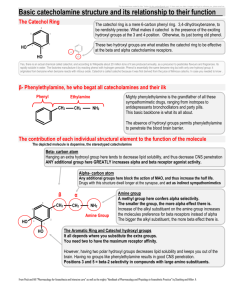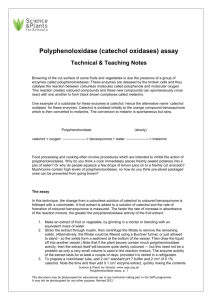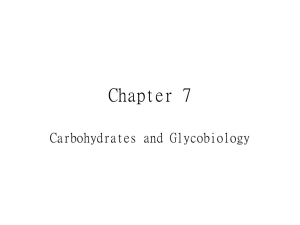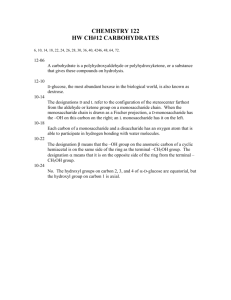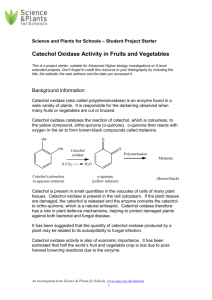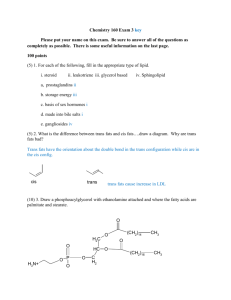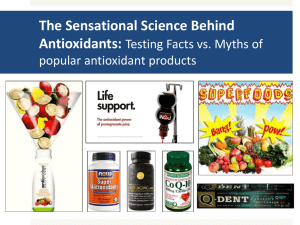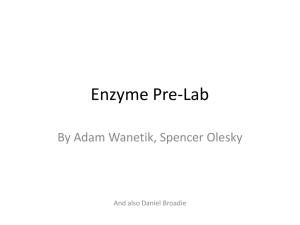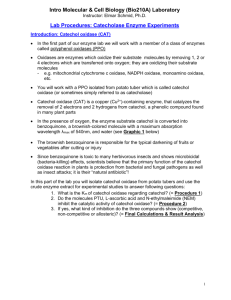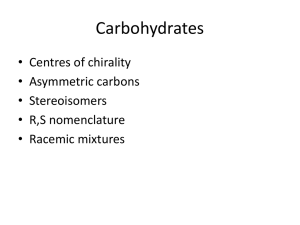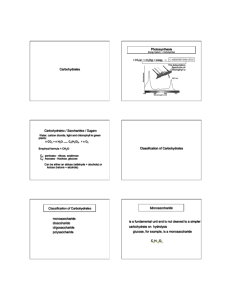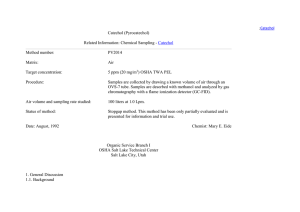biol1020lab2review
advertisement
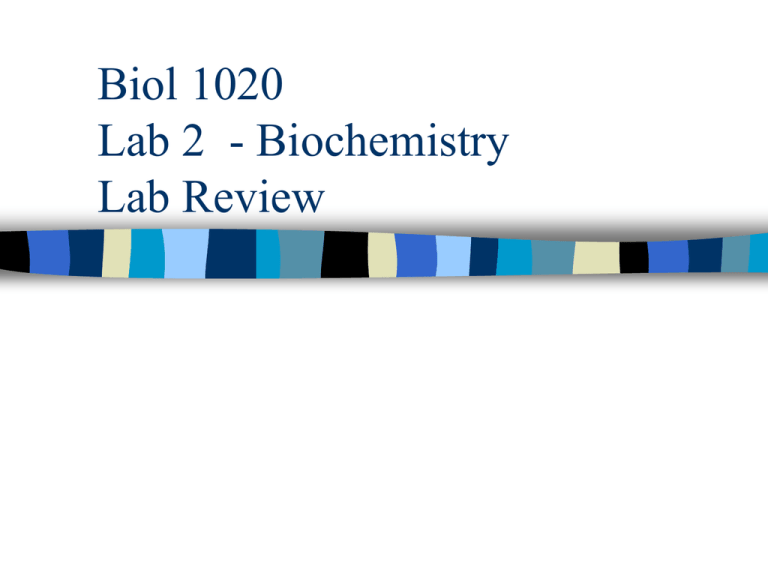
Biol 1020 Lab 2 - Biochemistry Lab Review Question 1 Which of the following would be found in starch? 6 CH2OH 6 O 5 OH B 4 OH H H 1 H HO 3 H H A 4 O 5 H H CH2OH OH H OH H HO 3 2 1 H 2 OH OH Question 1 Which of the following would be found in starch? This is a Glucose 6 CH2OH 6 O 5 OH B 4 OH H H 1 H HO 3 H H A 4 O 5 H H CH2OH OH H OH H HO 3 2 1 H 2 OH OH Question 2 If the 2 glucose's below were to join where and how would the bond form? 6 CH2OH 5 6 CH2OH O 5 H H O H H H H 4 4 1 1 OH H HO 3 OH OH 2 3 H H HO OH H 2 OH OH Question 2 The bond would form between the 1st and 4th carbon. It would involve the removal of an OH and a H. 6 CH2OH 6 O 5 5 H H H O H H H A 4 CH2OH 4 1 OH H HO 3 H 2 1 OH OH 3 OH H HO H 2 OH OH Question 2 The bond would form between the 1st and 4th carbon. It would involve the removal of an OH and a H. 6 CH2OH 6 CH2OH O 5 H H H H H H A 4 O 1 HO OH 1 H OH H H OH O 3 H OH A new a 1-4 bond OH Question 3 What is this type of reaction called? 6 CH2OH 6 CH2OH O 5 H H H H H H A 4 O 1 HO OH 1 H OH H H OH O 3 H OH A new a 1-4 bond OH Question 3 The reaction is a condensation reaction and involves the removal of water (H2O). 6 CH2OH 6 CH2OH O 5 H H H H H H A 4 O 1 HO OH 1 H OH H H OH O 3 H OH A new a 1-4 bond OH Question 4 Is glucose in this form a reducing sugar? Question 4 No- The double bonded Oxygen is part of the ring. We need to heat the solution to open the ring for the Benedicts test to be positive. Question 5 Which of the Catechol temperatures reacted fastest? A. Ice bath B. Room Temp C. 100ºC D. 40ºC Question 5 Which of the Catechol temperatures reacted fastest? A. Ice bath B. Room Temp C. 100ºC D. 40ºC Question 6 Why did the 100ºC Catechol not react? A.The catechol bonds were broken by the heat B.The catachol oxidase bonds were broken by the heat C. The catachol oxidase was denatured by the heat D. The catechol was denatured by the heat Question 6 Why did the 100ºC Catechol not react? A.The catechol bonds were broken by the heat B.The catachol oxidase bonds were broken by the heat C. The catachol oxidase was denatured by the heat D. The catechol was denatured by the heat Question 7 Why did the 0ºC Catechol not react? A.The catechol was destroyed by the ice B.There was not enough energy for the reaction to occur C. The potato was frozen D. The catechol oxidase was destroyed by the ice Question 7 Why did the 0ºC Catechol not react? A.The catechol was destroyed by the ice B.There was not enough energy for the reaction to occur C. The potato was frozen D. The catechol oxidase was destroyed by the ice Question 8 Which of the following would you think are non- polar molecules based on the ability to mix with oil? A. Ether B. Water C. Soap Question 8 Which of the following would you think are non-polar molecules based on the ability to mix with oil? A. Ether B. Water C. Soap The soap did not mix-it emulsified Question 9 Which of the following is a difference between a fat and a phospholipid? A. fats have 3 fatty acids and phospholipids have 2 B. fats have non polar heads and phospholipids have polar heads C. fats are used as an energy store while phospholipids form bilayers (membranes) D. fats usually contain only H,C,O while phospholipid also contain N and P Question 9 Which of the following is a difference between a fat and a phospholipid? A. fats have 3 fatty acids and phospholipids have 2 B. fats have non polar heads and phospholipids have polar heads C. fats are used as an energy store while phospholipids form bilayers (membranes) D. fats usually contain only H,C,O while phospholipid also contain N and P All are true Lab 2 - Biochemistry Your lab bench must be cleaned up before you leave. Place all of the test tubes back in the rack! Leave all material in its original location Biol 1020 Lab 2 - Biochemistry Lab Review
